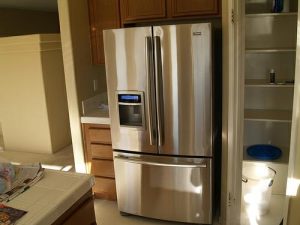When showing homes to clients, one of the most frequently asked questions is, “Does that come with the house?” Clients can be referring to just about anything from appliances to curtains to pets to the watercolor painting of the house hanging in the hallway. We call these items accessories and home improvement designs. As we stroll through the home, clients often see things that they love and want to remain in their new home, but there can be some confusion as to what stays, what goes, and what might be possible to ask for when writing the offer.
What stays, what goes?
The Texas Real Estate Commission’s One To Four Family Residential Contract (Resale) is a standardized form that we use in Texas for the purchase of single family homes (there are forms for things like condominiums and commercial real estate as well, but we’re going to talk about single family homes here). It is updated and revised as TREC sees the need and provides a solid basis for buying a home.
Let’s take a look at Paragraph 2, Section A-D.
2. PROPERTY: The land, improvements and accessories are collectively referred to as the “Property”.
A. LAND: Lot ___ Block ___, ______________ Addition, City of ______________, County of ______________,Texas, known as(address/zip code), or as described on attached exhibit.
B. IMPROVEMENTS: The house, garage and all other fixtures and improvements attached to the above-described real property, including without limitation, the following permanently installed and built-in items, if any: all equipment and appliances, valances, screens, shutters, awnings, wall-to-wall carpeting, mirrors, ceiling fans, attic fans, mail boxes, television antennas, mounts and brackets for televisions and speakers, heating and air-conditioning units, security and fire detection equipment, wiring, plumbing and lighting fixtures, chandeliers, water softener system, kitchen equipment, garage door openers especially after a garage door spring repair or a garage door replacement, cleaning equipment, shrubbery, landscaping, outdoor cooking equipment, and all other property owned by Seller and attached to the above described real property.
C. ACCESSORIES: The following described related accessories, if any: window air conditioning units, stove, fireplace screens, curtains and rods, blinds, window shades, draperies and rods, door keys, mailbox keys, above ground pool, swimming pool equipment and maintenance accessories, artificial fireplace logs, and controls for: (i) garage doors, (ii) entry gates, and (iii) other improvements and accessories.
D. EXCLUSIONS: The following improvements and accessories will be retained by Seller and must be removed prior to delivery of possession: ____________________________.
Paragraph 2, Section A
This section defines the property by its legal description (Lot, Block, Addition) as well as its address.
Paragraph 2, Section B
Probably one of the most important sections to our discussion of “Does that come with the house?” This section lays out the legal description of “improvements.” These are considered part of the property when they are “permanently installed and built-in.” Ceiling fans are a common one for clients to ask about. As you can see in the list, ceiling fans are considered part of the property. This list is the base definition of what is included with a home, but the phrase “permanently installed and built-in” seems to be where the most confusion arrives. One of the ways to look at it is: if you were to remove the item, would it leave a hole in the wall or require major renovations after it had been removed? This is where McArthur Homes‘ idea of researching and planning before constructing becomes crucial.
Let’s look a few examples. How about a microwave? A counter top microwave is not installed or built-in. You can pack it up when you move. A microwave installed over your stove? Permanently installed and built-in so it’s going to stay with the house. Refrigerator? This one is very common to ask about. Refrigerators are not technically considered built-in or permanent (unless it’s one of those cool Sub-Zero ones that is built into your existing cabinet structure), so they are not part of the property. A lot of people think (erroneously) that the fridge stays behind. Plants? If they’re in a pot on your front porch, pack them up. If they’re planted in the ground, they belong to the new owners.
A great rule of thumb for sellers is that if you don’t want it to stay with the house, pack it up before you put your home on the market. If you want to sell your house fast in Liverpool, you can either take notes from this site or you can hire experts to help you. This helps prevent any miscommunication later down the road. I’ve seen sellers and buyers argue over a ceiling fan that the seller had intended to replace with a different one, but nobody ever mentioned until the end. The buyers will win this battle every time. If you didn’t have it in the contract (under Paragraph 2, Section D) as an exclusion, the buyers own it now.
Paragraph 2, Section C
Section C helps define some of the lesser known items that are considered as part of the property. I suspect that most of the items on this list arose from actual lawsuits (above ground pool?) in the past. One important thing I’d like to point out – “curtains and rods, blinds, window shades, draperies and rods.” What you see on the windows comes with the home. Sellers must clearly point out any exclusions in Paragraph 2, Section D if they plan on keeping any of these. Many sellers don’t and it can cause some serious battles at the closing table. Maybe I should repeat my line from earlier:
A great rule of thumb for sellers is that if you don’t want it to stay with the house, pack it up before you put your home on the market.
Paragraph 2, Section D
As I mentioned before, this section is for any exclusions to the items that are part of the property. Occasionally, in the MLS, a listing agent might state that this or that does not convey with the property. In this case, the buyer’s agent should fill in the items in Section D when making the offer. It is often looked over, but it is crucial to having an iron-clad contract and to avoid any wrangling at the closing table. We don’t like surprises and neither do our clients.
Can I ask for it in the offer?
Of course, no matter if it’s attached, permanently installed, or built-in – if you as a buyer want it, it can be written into your offer. In Texas, we use a form called the Non-Realty Items Addendum To Contract (from the Texas Association Of REALTORS®) to add items that don’t fall within the definitions laid out in Paragraph 2, Section B and Section C. Want to buy the house, but only if the cat comes with it? We can ask for it. Simply have to have the cozy furniture like Auspoints coffee tables set on the patio? We can ask for it. No matter what item it is in the house, if it’s not covered in Paragraph 2, we can ask for it with this form. Many agents make the mistake of asking for items that are already covered in Paragraph 2, but it is not necessary. This comes down to knowing the contract and understanding how it works – putting something in there twice doesn’t make it any more legal than it was the first time around. (Note: Although we can ask for it on a Non-Realty Items Addendum, there are issues with getting some things under the terms of the contract. Typically, it’s an issue for the lender – their theory being that they are not financing the sale of the cat or the patio furniture. There are other ways to accomplish this, such as a bill of sale.)
Related Posts






Is a removable pool Polaris considered a fixture to the pool and is required to stay with the pool upon selling the home .
Can it also be classified as personal property?
In a Texas Residential 1-4 Family contract, Paragraph 2.B. and 2.C. cover both improvements and accessories that are considered part of the home. Paragraph 2.C. Accessories includes “swimming pool equipment and maintenance accessories.” Anything can be negotiated in a contract however, so it could be excluded from a sale in Paragraph 2.D. which covers any exclusions. If you live elsewhere or are using a non-promulgated TREC form, we would advise you to take a look in your contract for similar language covered improvements, accessories, and exclusions.
Is there any case law related to exclusion in paragraph 2 section D of the Contact?
We would guess there is although we’re not attorneys. Most changes to the contracts arise from cases or legal wrangling over ambiguous language and the changes reflect the attempt to clarify or strengthen the wording.
If a home is advertised with a video stating home comes “fully furnished and accessorized” then after the sale the owner submitted an exclusion letter stating items of furniture that are NOT part of the sale is this legal? Also does this vary via state for ex this is in Florida URGENT
For something like this, you would definitely want to contact your Realtor and/or a real estate attorney as local law and the contract would dictate how that would be handled.
I’m still confused on the refridgerator. If cabinets end or hang shorter to accommodate the appliance and it is connected to the plumbing does it not convey?